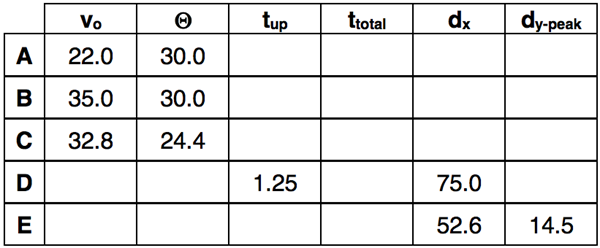Help for Master Difficulty Level
You can think of this difficulty level as involving five problems. Each row is a problem. And each row is independent of any other row. That is, for Row B, all you need to know is Row B information in order to determine the blanks in Row B. There are three ideas that you will use in determining the three blanks in each row. Here they are:
Calculating Times
The time to rise to the peak (tup) depends upon the original y-velocity (voy). The following equation is most often used.
vfy = voy - 9.8•t
At the peak position, the y-velocity is 0 m/s. This can be substituted into the left side of the equation for vfy. Once substituted, you can solve for t. This is the time to rise to the highest point - tup. The trajectory is symmetrical with respect to both position and time. And so the time to rise to the highest point is equal to the time to fall from the highest point. Doubling the value of tup gives you the total time in the air (ttotal).
Calculating Horizontal Displacement (dx)
The horizontal motion is rather straight-forward. There is only one equation that you will ever use:
dx = vox •t
The equation relates the horizontal displacement (dx) to the total time of travel (ttotal) and the original x-velocity (vox). You got this one!
Calculating the Vertical Displacement at the Peak (dy-peak)
Perhaps the easiest way to calculate the vertical displacement at the mid-way point of the trajectory (the peak) is to calculate the distance fallen from the peak to the ground. This distance after all is equal to the height at the highest point (dy-peak). The projectile will begin its fall with a vertical velocity (voy) of 0 m/s. So the term voy • t in the equation dy = voy • t - 4.9•t2 cancels out. And so the distance fallen (and thus, the dy-peak) is calculated from the simplified form of this equation.
dy = 4.9•t2
You got this too!
Some Specific Help on Row D
The value of tup and dx are given. You can calculate the second time - ttotal - using the information in the Calculating Times section above. You can then calculate the vox value using the only horizontal equation you'll ever use. Write the value down; you'll need to use it soon. Calculate the voy value using the tup value (see the section above on Calculating Times). Now with vox and voy known, calculate the vo using Pythagorean theorem and the angle of launch (Θ) using the tangent function. Drawing a triangle will help.
Some Specific Help on Row E
You will be working this problem in reverse. You are given the dx value and the dy-peak value. Begin with the dy-peak value; use it to calculate the tup value (see the Calculating Times section above). Then calculate the ttotal value. Now calculate the voy value from the tup value; once more refer to the Calculating Times section above. Write the value down to several decimal places; you will be using it soon. Then use the dx value and the ttotal value to calculate the vox value (see Calculating Horizontal Displacement). Once more, write the value down to several decimal places; you will be using it soon in two different calculations. Now use vox and voy values to calculate the original velocity (vo) using the Pythagorean theorem. And then use the tangent function to calculate the angle of launch (Θ).
